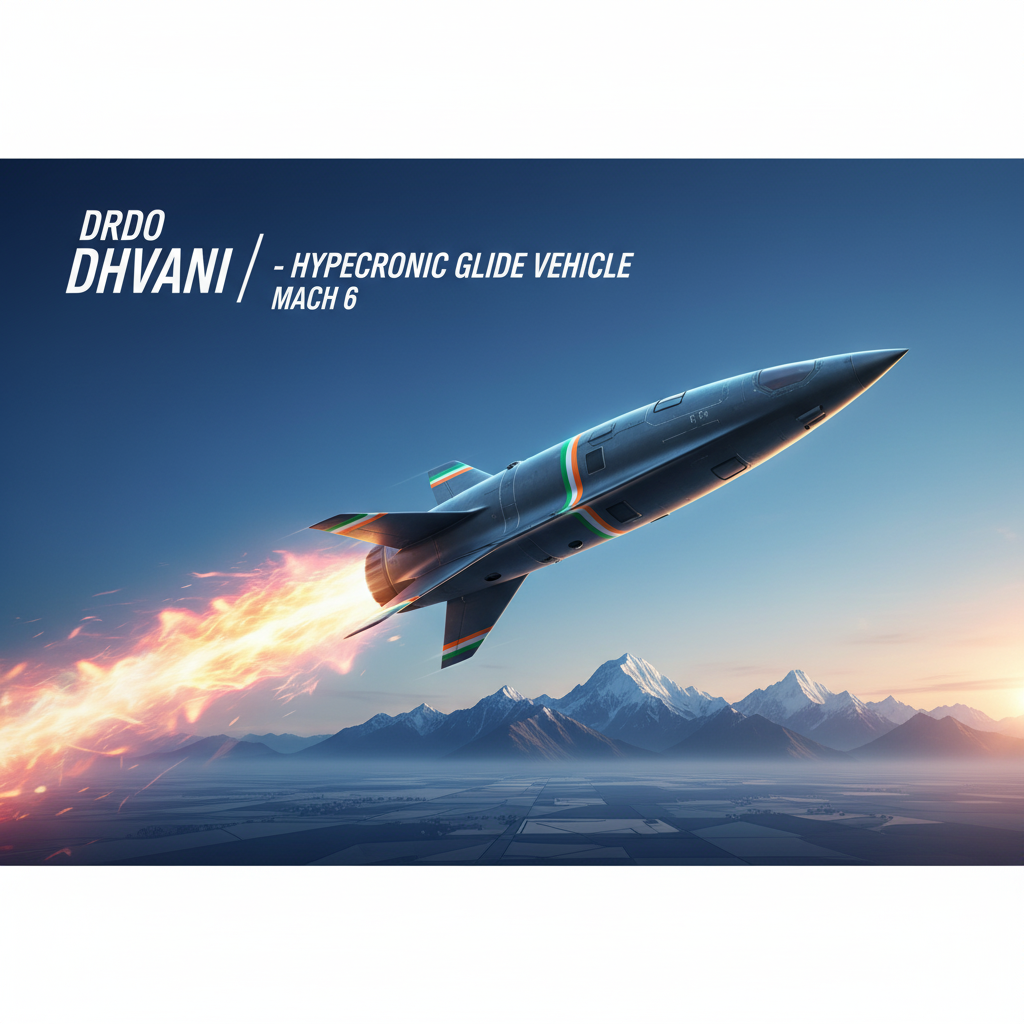DRDO’s Hypersonic Missile ‘Dhvani’: India’s Mach 6 Leap by End-2025
(Image: Conceptual rendering of DRDO’s Dhvani Hypersonic Glide Vehicle (HGV), set for testing by end-2025.)
Introduction: Dhvani – DRDO’s Game-Changer in Hypersonic Warfare
India’s Defence Research and Development Organisation (DRDO) is on the cusp of a strategic breakthrough with Project Dhvani, a Hypersonic Glide Vehicle (HGV) designed to soar at Mach 6 speeds (7,400 km/h), outpacing the BrahMos supersonic missile. With a full-scale model unveiled at the ‘Vigyan Vaibhav’ exhibition in Hyderabad on February 28, 2025, Dhvani represents India’s bold entry into the hypersonic arms race, rivaling Russia’s Avangard and China’s DF-ZF. Scheduled for testing by late 2025, this ICBM-class weapon could extend India’s strike range to 10,000 km, doubling the Agni-V’s 5,500 km.
Dhvani’s wave-rider configuration and maneuverability make it nearly impossible to intercept, reshaping regional deterrence. Building on the Hypersonic Technology Demonstrator Vehicle (HSTDV) tests, Dhvani positions India alongside the US, Russia, and China in hypersonic tech. This article explores Dhvani’s design, capabilities, timeline, and strategic implications. For more on naval advancements, see our INS Surat coverage.
Dhvani’s Design: Wave-Rider Innovation for Hypersonic Supremacy
Project Dhvani, led by DRDO’s Aeronautical Research and Development Centre (ARDC) and Defence Metallurgical Research Laboratory (DMRL), features a wave-rider configuration that “rides” its own shockwaves for efficient hypersonic flight. Launched via rocket booster to 40-100 km altitude, it glides unpredictably at Mach 5-6, evading defences like THAAD or S-500.
- Conical Body: Robust for stability, high lift-to-drag ratio.
- Winged Body: Delta wings for maneuverability in naval strikes.
- Blended Body: Stealth-optimized for intercontinental range (10,000 km).
Heat-resistant ceramics and ablative coatings withstand re-entry stresses, ensuring payload delivery (conventional/nuclear).
| Configuration | Speed | Range | Role |
|---|---|---|---|
| Conical Body | Mach 5+ | 1,500 km | Stability in ICBM-class strikes |
| Winged Body | Mach 6 | 2,000 km | Naval anti-ship missions |
| Blended Body | Mach 6 | 10,000 km | Intercontinental deterrence |
Capabilities: Mach 6 Evasion and Precision Strikes
Dhvani glides low after boost phase, executing sharp maneuvers that defy radar tracking. Faster than BrahMos (Mach 3), it strikes in <10 minutes over 1,500 km, with potential for MIRV warheads.
- Speed & Maneuverability: Mach 6 with plasma-sheath-defying turns, evading THAAD/Patriot.
- Payload: Conventional/nuclear; integrates with Agni-VI boosters or AMCA fighters.
- Launch Platforms: Air, sea, land—versatile for tri-service ops.
Timeline: From HSTDV to Dhvani Induction
DRDO’s hypersonic journey started with HSTDV (Mach 6+ tests, 2020-2022). Dhvani model unveiled February 28, 2025, at ‘Vigyan Vaibhav’.
- 2025: Full-scale test by December (coastal launch).
- 2027: User trials with Strategic Forces Command.
- 2029-30: Induction; range extension to 10,000 km.
Strategic Implications: Redefining India’s Deterrence
Dhvani counters China’s DF-100 (Mach 5-6) and Pakistan’s Ra’ad-II, securing India’s nuclear triad. It enhances deterrence with rapid strike capability, integrating with INS Surat’s naval power for a robust air-sea-land defense network.
Conclusion: Dhvani – India’s Hypersonic Future
Dhvani’s Mach 6 leap by end-2025 marks India’s ascent in hypersonic warfare, boosting Aatmanirbhar Bharat. For naval synergy, see our INS Surat coverage. What’s your take on Dhvani?
Poll: Will Dhvani Shift Regional Power Balance?
- Yes
- No
- Partially
Download Infographic: Dhvani Milestones 2025
Join the Conversation: Comment below. Follow @DefenceNiti on X! #DRDO #HypersonicMissile #AatmanirbharBharat



